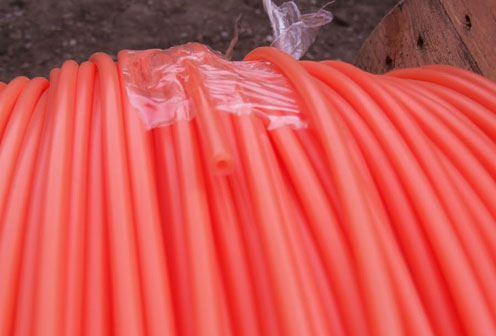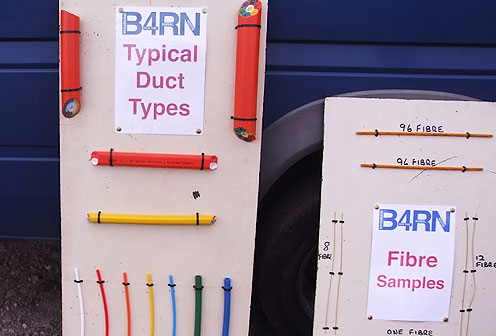Rural community fibre optic broadband project

B4RN stands for Broadband for the Rural North and is a community-run organisation providing superfast broadband to some of the most rural parishes in Lancashire.
The project involves delivering fibre to the home (FTTH) with cables stretching nearly 300km and connecting 1,452 households.
Fibre optic broadband is being rolled out in urban areas, but internet service providers consider it uneconomical to lay cables in rural areas.
“It’s not that rural people don’t have options, there’s satellite and wireless for example, but the best option is optical fibre and rural people shouldn’t be excluded from this,” says Mrs Conder.
This is a huge project, which requires a lot of volunteers to make it work. Local farmers dig the trenches using their own machinery and provide up to £2m for materials. Other funding is being raised through the sale of shares.
Digging has only just begun, but the first houses could be connected in a matter of weeks.
Although it is not a requirement, most of those who want a connection have purchased B4RN shares at £1 each. Shares are non-transferable, but are withdrawable and only redeemable at par so there is no opportunity for a capital gain. However, they can attract annual interest and offer tax relief.
Installation will cost B4RN around £1,000 a household, with about 60% of that accounted for by materials rather than labour.
The cables usually laid by telecommunications companies are beneath roads and other infrastructure, which are not necessarily the most straightforward routes.
This is mostly because it is easier to get permission to lay cables under highways than to seek permission from many different landowners. B4RN is able cut some of these costs by directly negotiating with landowners for wayleaves.
Because many of the landowners are involved in the project and it is not for capital gain, getting their permission is not usually a problem.

How does it work?
Fibre optic cables laid in shallow trenches connect properties directly with a broadband source, in B4RN’s case Telecity in Manchester, via a node (a hub for fibre optic cables). B4RN has five village nodes with 40 cables radiating from these to all properties in the coverage area.
Benefits
- “future proof”, ie, not likely to be overtaken by other technology in near future
- superfast speeds of 1gbps
- managed by community
- extremely reliable
- also includes phone line
Downsides
- expensive on a small scale (ie, one village or smaller)
- requires a great deal of community involvement and time
Costs
With the B4RN project, there is a one-off connection charge of £150, then a £30 monthly broadband charge. This also includes a telephone line at no extra cost except for calls.
Permissions
Wayleave agreements must be granted by all landowners, and Ofcom permission sought. Projects register with a Regional Internet Registry and with the Financial Services Authority if run as a business, even if not for profit.
Legal issues
As well as legal issues surrounding shares and wayleave agreements, organisations must take care to train and protect project volunteers. Heath and safety training may be needed – those laying cables must be certified competent after a course, such as the five day City & Guilds fibre optic installation and testing fast-track course. Volunteers working on the highways will need to comply with the New Roads and Street Works Act.
Speeds
The B4RN project will receive a 1gbps symmetrical service. This means users get a 1gbps (1,000 mbps) service for both upload and download, making online games, phonecalls and social networking (uploading photos, for example) much quicker than a standard asymmetric connection.
What do you need?
The B4RN project is so far successful because the community has the right mix of technical knowledge (chief executive Barry Forde is a networking expert), practical skills and community enthusiasm.
Range
In theory there is no limit to the distance the cables can be laid, as long as they are able to connect to a broadband source. Fibre optic cables suffer less signal degradation than copper, so are great for rural areas where properties are further apart.
How many people can use it?
There is no limit to the number of people that can use fibre optic broadband, but provisions are being made for spare cables in case more residents want to be added later. B4RN is allowing for at least 10% spare fibres for future builds and unforeseen circumstances.
How do I go about it?
B4RN is working in eight parishes in rural Lancashire (Over Wyresdale, Quernmore, Roeburndale, Wray with Botton, Tatham, Wennington, Melling with Wrayton and Arkhome with Cawood) and residents should contact B4RN for information about getting involved. Any rural community can follow in B4RN’s footsteps. Go to www.b4rn.org.uk for more information about the project.
Case study
Andrew Taylor
Tatham, Lancashire
As you’d expect from a rural area, there are many farmers involved in B4RN. Their practical skills and equipment are essential to the cable-laying process. Beef and sheep farmer Andrew Taylor, who also owns a groundwork company, will be solely responsible for digging 1km of trenches between his home and the nearest connection point.
“It’s a massive project and there has been a lot of money pledged,” says Mr Taylor. “Although you don’t have to be a shareholder, I, along with most people, have put in £1,500 and with that we get the first year’s connection included.
“There’s no cash involved, but I will also be paid in shares for the work I do. I’m digging the trenches for my own connection but I might be digging others too, as I have machines available. It will probably take me four or five days to do the stretch up to my house.
“It’s a very forward-thinking project and will secure a future for our area.”
For more on this topic
Go to our rural broadband campaign page

